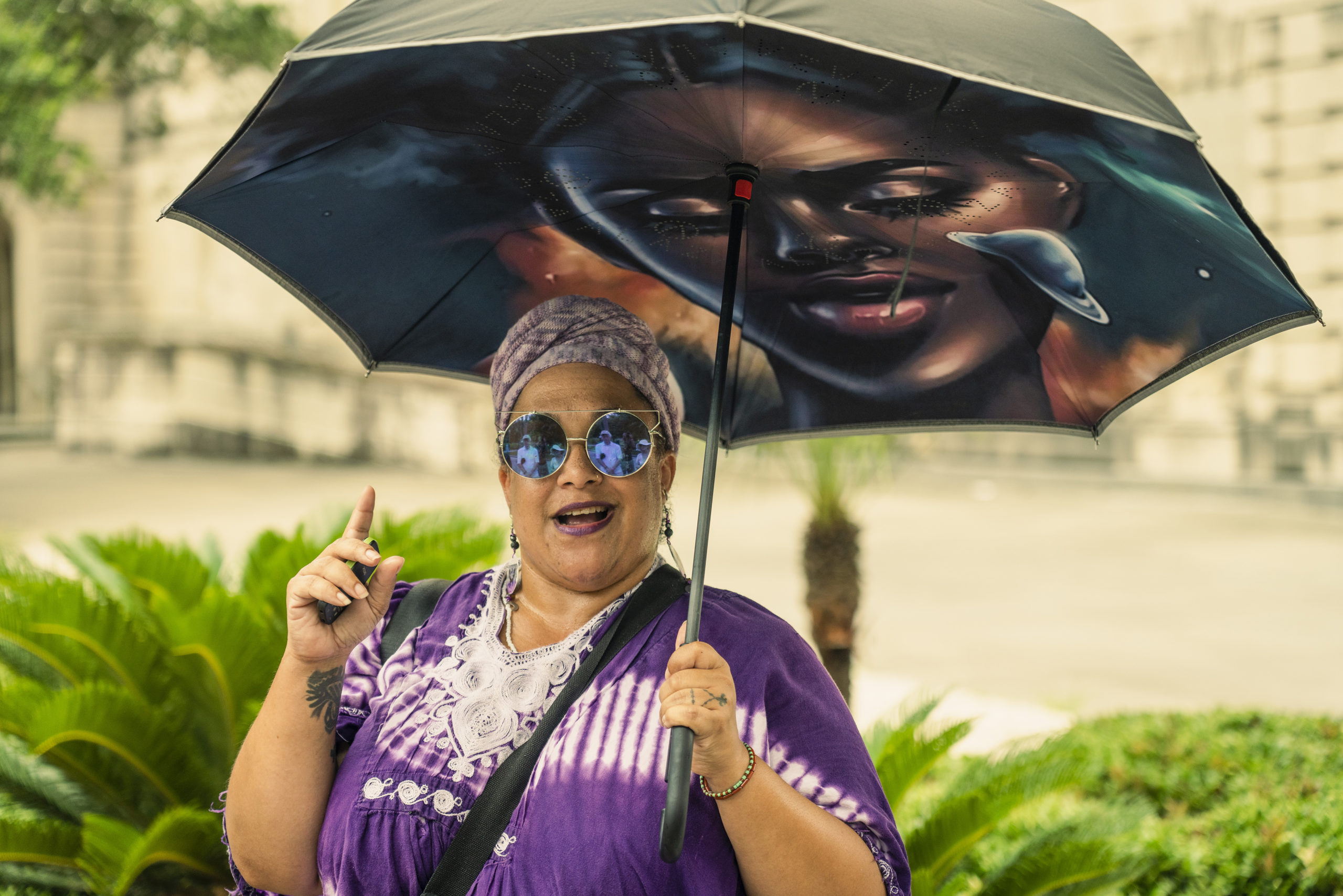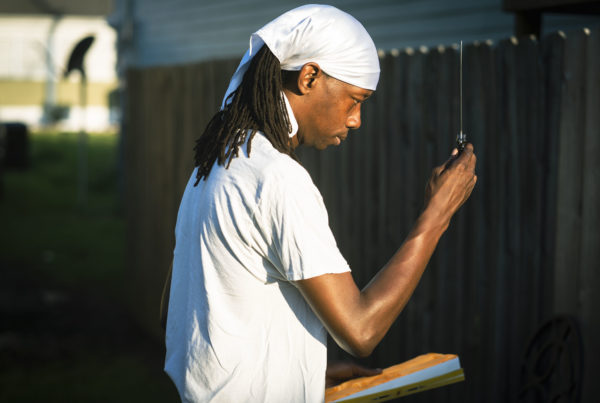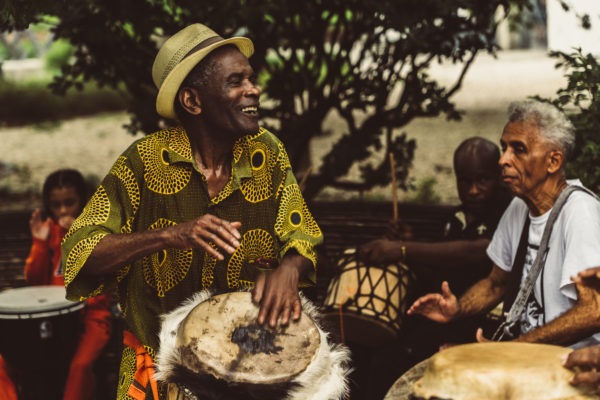No products in the cart.
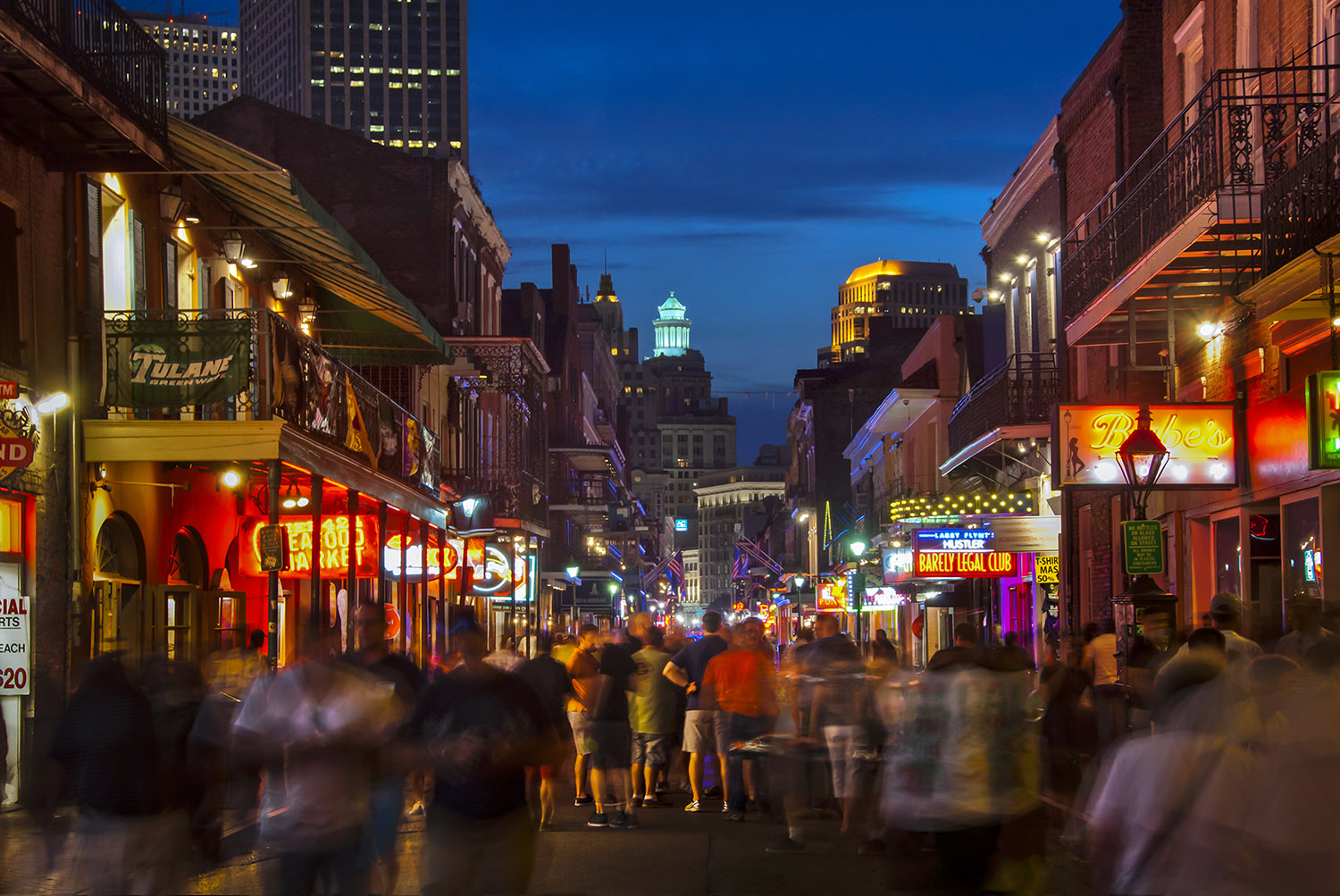
Pedestrian friendly Bourbon Street is lined with clubs and bars in New Orleans, Louisiana.
The Blackest Ghost Tour in America
“Black history is Black horror.”- Tananarive Due, Horror Noire Documentary, 2019
While people flock to New Orleans in droves to be titillated and terrified by the brutality experienced by those enslaved, the air changes when detail is offered with regard to the context of slavery itself in connection with the atrocities perfomed. The air in New Orleans is already excessively dense; the word “soupy” comes to mind. Some posit it’s the city’s proximity to sea level, but for those of us who are sensitive to the presence of our Ancestors, we know better.
One tour company in particular has made it their mission to share the ghost stories of New Orleans from the standpoint of honoring the truth behind why the city is so haunted: namely, New Orleans was one of the most active slave ports in the nation.
Anansi’s Daughters, LLC. was founded in June of 2022 by myself (Malika Hadley Freydberg), and Eshé (Mary Jackson) to ensure the stories shared about the ghosts of New Orleans are done in an accurate and thorough manner, using the vehicle of oral history as the medium. While there has always been a fascination with the tragic mulatto trope, guides have often been cautioned by supervisors not to get “too deep” into it. They want to make sure no one is being made to feel uncomfortable. We want to be true to the history as a writers and guides, so it is something we have struggled with. In turn, we opened our own tour operator business, and private guided experiences.
We introduced “The Blackest Ghost Tour” as one of the first experiences offered, with the objective being to make it clear to tour guests that, if they are of the ilk who want to hear about the horrors of the city without the reality of the experiences of those enslaved being the foundation of those stories, this may not be the tour for them.
One of the biggest draws to the ghost tours in New Orleans has been American Horror Story Season Three: Coven. It introduces the characters Delphine LaLaurie, portrayed by Kathy Bates, and Voodoo Queen Marie Laveau, as portrayed by the incomparable Ms. Angela Bassett. Though even before that particular season of the show, the LaLaurie mansion has long been billed as the most popular ghost story in New Orleans. Not only does it star a female serial killer from the true crime history of the Crescent City, but it comes with a trove of terrifying tortures meeted out by one of the most revered members of French Aristocracy in the colony.
The Lalaurie Mansion
Delphine LaLaurie, born Marie Delphine McCarty, is a character portrayed by Kathy Bates in American Horror Story Season Three: Coven. As a result, the mansion at 1138 Royal St., which takes up the entire corner of Governor Nicholls and Royal in the French Quarter, has thousands of tourists outside every night of the year.
Delphine LaLaurie was a socialite among the elite in early-mid 1800s New Orleans. It is said that she threw fabulous soirees at her residence in the Vieux Carre almost every other weekend. On the evening of April 10, 1834, the most widely shared version of this story states that she would be throwing what would turn out to be her last party, when a fire breaks out.
There are several versions of what was found on what was the top floor of the mansion that night, but the consensus is that she had been keeping several enslaved people in a locked room where there is historical evidence of brutal torture, gruesome medical experiementations, and murder at the hands of Delphine LaLaurie.
Indeed, it is the tortures and pain inflicted on the enslaved that guests come to hear about. Each tour company has their own versions of what was suffered by those terrorized and murdered, but tour guide Eshé (Mary J.) of Anansi’s Daughters went several steps further by studying dissertations, the diaries of slave-owner Thomas Thistlewood (property of Yale University), and cross-referencing the folklore being shared by the tour companies with the records kept at Whitney Plantation in Wallace, Louisiana. She compiled all the research-supported means of “discipline” that were commonly used against the enslaved, and created a version of the story that served to elucidate the realities of what was experienced in the mansion, as opposed to the all-too-common glorification and exploitation of the terrors endured by those enslaved.
Buckner Manor
Another site famous for its inclusion in AHS Coven was Buckner Manor at 1410 Jackson Avenue. Built in 1856, the 166-year-old mansion was used in the show as the exterior of Miss Robecheaux’s Academy for Gifted Girls (a school for witches grades K-12, essentially.) The Garden District’s official website offers a story about the ghost of the manor, Miss Josephine. The tale is framed in a fashion where Miss Josephine so enjoyed her tenure as an enslaved person at the house that she chose to stay on with the family after the Civil War as the paid maid. It’s said you can still hear her sweeping in the hallways when no one corporeal appears to be tidying up and that the chandeliers will sway every so slightly as though she is still up there dusting. It is even said that, should anyone with a modicum of Buckner blood cross the threshold of the manse, Miss Josephine will appear on the main staircase to welcome that person home.
What the above account shows is a fervent desire for a retelling of history that not only sanitizes the very real horrors experienced by those enslaved, but the comfort sought through the continuation of enslavement past death at the choice of the person who was enslaved during life. This allows not only for a shiver down the spine at the thought of specters in the hallways, but the assurance that no harm will be done, because those enslaved were so comfortable in their stations that they willingly continue to serve as such in their afterlife.
Upon telling the story of Miss Josephine as shared on the website since November of 2021, I (Malika) found it increasingly more difficult to breathe when I got to Miss Josephine’s part of the history of Buckner Manor when giving tours. An initiate of three African Traditional Religions, I realized immediately that I was telling a version of a story this particular Ancestor was not happy with: she was making it difficult for me to speak.
Through speaking with a multi-generational New Orleanian, I was informed that it was more likely she would’ve been an indentured servant after the Civil War, as opposed to having chosen to continue working for the family. This prompted me to go back over the entire story, and see how glaringly wrong this telling had to be. I left an offering to Miss Josephine the next time I went to the manor in the form of three small mason jars; one containing gin, which is used for prayer in many West African traditions, one with rum, used in prayer in the Caribbean, and one with champagne, in hopes that Miss Josephine was not still working in her afterlife, but taking time to relax and enjoy her freedom.
Anansi stories
With regard to stories learned throughout childhood, many guides of Color grew up on the “Anansi” stories. Sourced from the Ashanti Akan in Ghana, the Anansi stories are one of the few vestiges of African culture that managed to remain intact through the Middle Passage.
Kweku Anansi is a trickster of a spider spirit, who weaves tales in his web. Most of the stories are centered around his ability to trick animals much bigger than himself to find his way out of the trouble he so naturally creates.
In the beginning of my career as a tour guide, I chose one of these stories as my audition piece for a tour company here in New Orleans. Anansi went over very well with my soon-to-be boss, though it later turned out his frame of reference for Anansi was sourced by the Caucasian English writer, Neil Gaiman. I hadn’t heard of Gaiman yet, and he hadn’t heard original Anansi stories, so we were both better for the shared experience. It was not lost on me, however, that while the Africentric story was somewhat recognized and enjoyed by my future employer, their reference was not one of origin, i.e. the stories that made it through the middle passage about the trickster spider, Anansi.
The Bourbon Orleans Hotel
One of the ghost stories told in the Quarter is about the free women of Color who haunt the Bourbon Orleans hotel. Within the context of one of those stories, there is a character described as “Octoroon”, and there is also reference to the “Quadroon Balls” that were once so popular in 19th century New Orleans.
Chronologically, the first story to be shared is in direct reference to the aforementioned “Quadroon Balls”, with the introduction of the character Giselle, or the lady in red. The account consists of a woman in her early 20’s, attending the balls to find a match with a wealthy European man to care for her. This was one of the most coveted of positions to find oneself in as a free woman of Color, for if you did not find a match, you would be relegated to factory or domestic work, or work in a brothel.
Suffice it to say, Giselle did not find her match, and ultimately ended her life in the face of what few options would be left to her without the protection of a match with a Frenchman. It is said she still haunts the ballroom to this day, always described as wearing a floor length antebellum gown, dancing beneath the crystal chandeliers at the Bourbon Orleans.
A few decades after the Quadroon Balls were held in that ballroom, that same location became the home to the Sisters of the Holy Family, which is the second African-American convent in the nation. The founder, Henriette Delille, is up for canonization at the Vatican as our first African-American saint.
The Sisters held classes for free girls of Color in the ballroom, as well as an infirmary for those suffering from yellow fever. The latter was the number one killer of New Orleanians until 1905, with 1853 being the worst summer in the history of the city. This aligns with the time the Sisters would have had their infirmary up and running. That particular summer, the mosquito-carried yellow fever killed 10% of the population. Some of the nuns contracted yellow fever, as well as some of the little girls who attended the school, resulting in their untimely deaths within the walls of the Bourbon Orleans.
It is said the ghost girls like to play hide and seek in the hallways, while the spirits of the nuns who have yet to ascend wrap the knuckles of the occasional guest, should they behave in an unseemly fashion. The hotel itself has its own in-house ghost tour that can be enjoyed by the guests who are staying there.
This allows for the stories to be told with autonomy and without censorship. The guides can showcase the horrors and triumphs of our Ancestors within the context of ghost tours. The cobwebs can be swept away that obscure the terrifying realities those before us experienced, as well as set the stage for their funnier antics and mischievous afterlives. The connection can be made between the trickster Spirit Anansi, and how that savvy manifested itself through those who have gone before, as well as where that slyness shows up today in modern hauntings throughout the city.
To book “The Blackest Ghost Tour”, please visit www.anansisdaughters.com and our Tripadvisor.
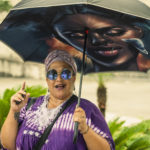
Malika Freydberg
Malika Hadley Freydberg is a multi-medium performance and visual artist based in New Orleans, Louisiana, as well as co-owner and tour guide of walking tour company Anansi’s Daughters, LLC. She’s a four time national slam poet, and has graced the final stage in two of those four competitions. Malika holds a B.A. in Arts Management-Music from Bennett College in Greensboro, NC (HBCU PRIDE!), and a Masters in Music Education, focus in Choral Conducting and Ethnomusicology from Georgia State. She lives in a house with a purple door with her wife and three cats.
